 |
Our field school season ended on June 21st. In the coming months, we will begin the long process of analyzing the artifacts that we excavated during the summer. We found a very large quantity of artifacts--something in the range of 10,000 objects--, and these materials span the period from about 1890 until the present. In the final days of the field school we concluded excavations within the store's foundations, and these units revealed some of our earliest and most undisturbed turn-of-the-century contexts. The quite-recent past is very well represented, too: for instance, a cistern excavated during the last week of the field school contained roughly 250 bottles and several thousand objects that date to the period after World War II. Earlier in the summer we also excavated a well, which was described in the June 10th field school report, and its contents appear to date to about 1930. Consequently, we have a nice cross-section of archaeological deposits spanning the lot's full residency.
| Section links (click on any of these to jump ahead in this page) |
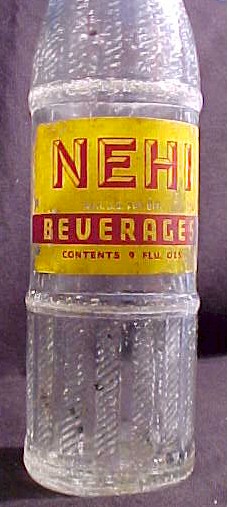 Most
archaeology focuses on the distant past, and even archaeologists who study the
period since European colonization tend to devote most of their time to studying
early historical periods that we know little or nothing about without
archaeology. Indeed, we met many not-so-elderly visitors this summer who
had shopped in this Camp Street corner store or remember its owners, and there
is a fair volume of textual documentation of the neighborhood and its
residents. Consequently, it might seem a little superfluous to do
archaeology of a place that seems so well documented and understood already.
Most
archaeology focuses on the distant past, and even archaeologists who study the
period since European colonization tend to devote most of their time to studying
early historical periods that we know little or nothing about without
archaeology. Indeed, we met many not-so-elderly visitors this summer who
had shopped in this Camp Street corner store or remember its owners, and there
is a fair volume of textual documentation of the neighborhood and its
residents. Consequently, it might seem a little superfluous to do
archaeology of a place that seems so well documented and understood already.
Regardless of whether the site dates to the Upper
Paleolithic or today, our project assumes that archaeology can illuminate
symbolism, patterns, and systemic relationships that are not necessarily clear
to the people who consume these goods. One of the key insights to come
from William Rathje's research on contemporary garbage is that we know very little about our
personal consumption patterns. Since the 1970s Rathje has studied folks'
garbage and consumption behaviors and found that when we are quizzed on these
behaviors we have a poor understanding of what we actually eat, drink, or
discard; consequently, much of the material world's influence on our identities
passes unnoticed. The Ransom Place project operates under the same assumption that systematic material
analysis will identify often-unrecognized patterns in material consumption that
archaeologists can subsequently link to broader social structure, economic
currents, or dominant ideologies like racism. Consequently, there is no
reason we cannot, for instance, do an illuminating analysis of Cold War America
using the cistern's bottles; likewise, we might use the site's record of nearly
a century of modest entrepreneurship to examine the formidable barriers that
African-American business people faced. We will still do exactly the same
sort of material analysis that we would conduct on a colonial assemblage:
in the circa 1950 cistern, for example, we'll identify and count every object,
reconstruct vessels, and identify the types of bottled goods represented in the
feature. We will do the same textual research that a historical
archaeologist might do for an eighteenth-century site, but with somewhat
different sources. For instance, we'll examine the marketing of the
products consumed at 800 Camp Street, probing things like the symbolism in
product advertising, pricing, and so on. How might ads have been distinctive in 1951 (when this Coke ad
to the right was produced)?; how might these ads reflect dominant social
attitudes at that moment?; and how might this symbolism have shaped the way
various consumers saw something as apparently insignificant as a cola? Perhaps this might not initially sound quite as thrilling as
finding a very early historic site, but plenty of passers-by were certainly
fascinated by the long lines of bottles being handed out of the feature, and the
bottles' dated post-war aesthetics were the subject of considerable musing
amongst the field school crew: we think this curiosity is a good
indication that socially significant symbolism lurks within these commonplace
things, regardless of when they were made or discarded.
and so on. How might ads have been distinctive in 1951 (when this Coke ad
to the right was produced)?; how might these ads reflect dominant social
attitudes at that moment?; and how might this symbolism have shaped the way
various consumers saw something as apparently insignificant as a cola? Perhaps this might not initially sound quite as thrilling as
finding a very early historic site, but plenty of passers-by were certainly
fascinated by the long lines of bottles being handed out of the feature, and the
bottles' dated post-war aesthetics were the subject of considerable musing
amongst the field school crew: we think this curiosity is a good
indication that socially significant symbolism lurks within these commonplace
things, regardless of when they were made or discarded.
Archaeological projects that investigate sites within the
memory of living folks might seem irrelevant, since we do have
living people to talk to. However memory is a fickle thing, distorted and
shaped by time, personal experience, and occasional romanticism for a past that
never really existed. Our project is particularly interested in how
archaeological material culture and 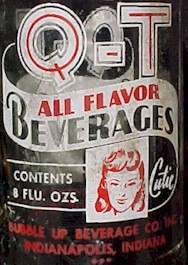 oral histories end up often telling somewhat
different stories about more-or-less objective events: these discrepancies
between what we think material culture is showing us and what various folks have
in their memories is one of the key things that distinguishes how historical
archaeologists interpret the past. One of the things we assume on our
project is that all our interpretations of the past--whether they are personal
memories or archaeological analyses--are inevitably shaped by the present, so
there must be a connection between the two, regardless of the
"distance" in time between the past and present. To a certain
extent time is utterly "constructed": that is, we
socially share a way of defining the past (usually as a long continuum of
related events leading to us), and we can literally choose events, subjects, and periods to focus on
while we ignore others. Archaeologically we've tended to ignore recent
material culture, in large part because the laws regulating archaeology aren't
designed to preserve most twentieth-century archaeological material culture, and
some potential research questions have not been very extensively examined.
However this certainly does not mean we cannot find meaningful research
questions in twentieth-century refuse and ask complex questions about the peoples' lives that
this trash reflects.
oral histories end up often telling somewhat
different stories about more-or-less objective events: these discrepancies
between what we think material culture is showing us and what various folks have
in their memories is one of the key things that distinguishes how historical
archaeologists interpret the past. One of the things we assume on our
project is that all our interpretations of the past--whether they are personal
memories or archaeological analyses--are inevitably shaped by the present, so
there must be a connection between the two, regardless of the
"distance" in time between the past and present. To a certain
extent time is utterly "constructed": that is, we
socially share a way of defining the past (usually as a long continuum of
related events leading to us), and we can literally choose events, subjects, and periods to focus on
while we ignore others. Archaeologically we've tended to ignore recent
material culture, in large part because the laws regulating archaeology aren't
designed to preserve most twentieth-century archaeological material culture, and
some potential research questions have not been very extensively examined.
However this certainly does not mean we cannot find meaningful research
questions in twentieth-century refuse and ask complex questions about the peoples' lives that
this trash reflects.
 |
Our project assumes that any single object can mean a circumscribed range of things. The alumaseal milk caps in the 941 Camp Street page provide a good archaeological example of how symbolism can vary from one person to the next; some archaeologists call this "multivalence." Today examples of multivalence surround us everywhere we look. For instance, a sport utility vehicle (i.e., an SUV) is functionally an internal combustion engine vehicle, no matter how liberally you interpret material symbolism. However, the social meaning of this objective thing is very difficult to pin down. On the one hand, some folks see SUVs as stylish, utilitarian, safe, and/or high-status vehicles; on the other almost diametrically opposed hand, some people see SUVs as environmentally insensitive, vulgar class statements, and antisocial shows of profligacy that are no more likely to witness four-wheeling than the average station wagon (cf. the SUV Anti-Fan Club site). Can one thing take on such caricatured meanings? If it can, does this totally disable archaeology's capacity to say something meaningful about the past? From this dizzying range of symbolism attached to the same objective good, how can we interpret a consumer's identity?
One way we can begin to probe this question is by looking at ethnicity and cultural identity at 800 Camp Street. Archaeologists assume that there will be some material indications of a consumer's "identity"--this identity is usually a complex brew of relatively ambiguous terms like culture, ethnicity, race, and a number of other concepts that vary from one time and person to the next. Most of us don't really define these terms precisely, and even archaeologists sometimes use these concepts rather loosely. Ethnicity, for instance, is defined a very wide range of ways that typically focus on an individual's professed region of origination: e.g., you might call yourself Irish American, African American, or use similar concepts that could refer to a country (e.g., Ireland) or a region (e.g., Africa). This project defines ethnicity as something we consciously give ourselves: we adopt an ethnic identity because it empowers us in some way, usually by providing a heritage in which we take pride. The Madame Walker Theatre in Indianapolis, for example, is an artifact of ethnic empowerment, like much of the material culture that came out of the Harlem Renaissance. The Theatre incorporates a vast range of African imagery that stressed the rich heritage of diaspora peoples, which was a bold statement in 1920s Indianapolis. But how might we see such ethnic identity and multivalence in more commonplace everyday commodities?
| It makes sense to start with artifacts that have apparently clear ethnic imagery, but even in these cases our sense of clear boundaries between ethnic groups begins to fall apart. For instance, a yard unit contained the bronze brooch illustrated to the right. The brooch's African profile reflects several different social currents. Foremost was the continued expansion of Afrocentrism that took quite powerful philosophical, material, and political forms after World War I, including the well-known artistic, literary, and intellectual products of the Harlem Renaissance. | 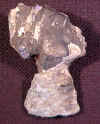 This brooch bears an African likeness that was probably influenced by
Afrocentric social and aesthetic movements that were quite powerful after World War
I. The heavy brooch was likely worn on sturdy clothing, such as a
coat. The brooch has a safety clasp, a closure technology introduced
around 1930. This brooch bears an African likeness that was probably influenced by
Afrocentric social and aesthetic movements that were quite powerful after World War
I. The heavy brooch was likely worn on sturdy clothing, such as a
coat. The brooch has a safety clasp, a closure technology introduced
around 1930. |
 An increasing number of African Americans had been
interested in their African cultural roots since the nineteenth century, and by
the end of World War I a movement had emerged that many contemporaries called the "New
Negro." This term was used in a range of ways, with some figures
stressing artistic and creative production and others advocating a more
assertive politics. Because it was the new home to many African Americans migrating from
the South, Harlem became the center of an explosion of "New Negro" creative, intellectual, and political thought. Inevitably African
Americans began to consume material goods that appropriated African motifs or
came from the continent. At about the same time, in 1922 Howard Carter
opened Tutankhamen's tomb and unleashed a flood of Egyptian-themed material
culture that many African Americans consumed for its African symbolism.
The rise of African-American stars such as Josephine Baker also was celebrated
in objects such as prints and jewelry, and Black newspapers were filled with ads
for "race" prints that commemorated a range of African-American
historical figures and themes.
An increasing number of African Americans had been
interested in their African cultural roots since the nineteenth century, and by
the end of World War I a movement had emerged that many contemporaries called the "New
Negro." This term was used in a range of ways, with some figures
stressing artistic and creative production and others advocating a more
assertive politics. Because it was the new home to many African Americans migrating from
the South, Harlem became the center of an explosion of "New Negro" creative, intellectual, and political thought. Inevitably African
Americans began to consume material goods that appropriated African motifs or
came from the continent. At about the same time, in 1922 Howard Carter
opened Tutankhamen's tomb and unleashed a flood of Egyptian-themed material
culture that many African Americans consumed for its African symbolism.
The rise of African-American stars such as Josephine Baker also was celebrated
in objects such as prints and jewelry, and Black newspapers were filled with ads
for "race" prints that commemorated a range of African-American
historical figures and themes.
 The Camp Street brooch, which dates to the 1930s, likely
reflects these currents in African-American ethnic and cultural
consciousness. The brooch is equal measures ethnic and cultural
construction in its effort to identify historical and social continuity in
diaspora experience, and in many ways it likely was considered a rebuttal of
anti-Black racism since it depicted a woman of color in non-racist aesthetics.
Many pieces of jewelry made of alloys collectively known as "pot
metals" depicted Josephine
Baker, the African-American performer who
achieved her greatest popularity in Europe. Born in 1906, Baker appeared
on Broadway in 1921's Black musical Shuffle Along, and in 1925 she went
to Paris and won widespread renown as an elegant dancer and sensual
performer. Baker never won a widespread White following in the United
States, and she became a French citizen in 1937 and eventually served in the
French Resistance during World War II. Yet because of Indianapolis' very active jazz and entertainment
venues, many African Americans in the near Westside would have been quite
familiar with Josephine Baker. The Camp Street brooch is not
a particularly clear likeness of Baker, so it may have been crafted as a
generalized African-American image or a
loose evocation of Baker.
The Camp Street brooch, which dates to the 1930s, likely
reflects these currents in African-American ethnic and cultural
consciousness. The brooch is equal measures ethnic and cultural
construction in its effort to identify historical and social continuity in
diaspora experience, and in many ways it likely was considered a rebuttal of
anti-Black racism since it depicted a woman of color in non-racist aesthetics.
Many pieces of jewelry made of alloys collectively known as "pot
metals" depicted Josephine
Baker, the African-American performer who
achieved her greatest popularity in Europe. Born in 1906, Baker appeared
on Broadway in 1921's Black musical Shuffle Along, and in 1925 she went
to Paris and won widespread renown as an elegant dancer and sensual
performer. Baker never won a widespread White following in the United
States, and she became a French citizen in 1937 and eventually served in the
French Resistance during World War II. Yet because of Indianapolis' very active jazz and entertainment
venues, many African Americans in the near Westside would have been quite
familiar with Josephine Baker. The Camp Street brooch is not
a particularly clear likeness of Baker, so it may have been crafted as a
generalized African-American image or a
loose evocation of Baker.
| Much of this information on Josephine Baker jewelry came from costume jewelry collector Isabelle Bryman; for more information on jewelry depicting Baker and a discussion of how jewelry means different things depending on who wears it, visit Isabelle's informative Costume Jewelry page. |
Because ethnicity is itself so fluid, the presence of Jewish symbolism does not mean that African Americans might not have consumed or, in this case, even sold such goods. Kids, for instance, might have readily re-defined or simply ignored the discs' symbolism and integrated them into any number of activities, and some African-American adults may not have considered the cultural symbolism antithetical to their own identity or really reflected upon it at all. The near-Westside certainly had Jewish residents into the twentieth century, but by the 1940s very few Jews were living in the near-Westside. The path by which these objects made their way into the Camp Street lot will never be known, but we can begin to wrestle with thinking about what they meant in the hands of African-American consumers and examine the flexibility of ethnic identity.
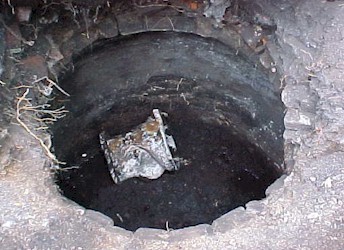 Everything
and the toilet, too: the Camp Street cistern Everything
and the toilet, too: the Camp Street cistern
Sometime in the 1950s, the residents of 800 Camp Street filled the cistern in their backyard with a dense assemblage of bottles, cans, and construction debris like this toilet, which apparently was among the first objects discarded into the cistern. The brick cistern had a rough bottle-shaped profile, with its surface diameter just short of three-feet wide and its interior diameter five feet. Excavation was concluded at six feet when the feature began to fill with water. The feature included about 200 bottles that were whole or nearly whole, with locally bottled products quite common --Indianapolis NEHI bottlers, for instance, are represented, and quite a few bottles from the Polk Sanitary Dairy in Greenwood were recovered as well. These vessels may have been products sold at the store, and the feature itself may have been filled when the store was finally closed: this would be an unusual assortment and quantity of goods in a typical household. The cistern had no significant soil variation, which we would expect if the feature had been filled gradually and subjected to the weather, and it had a fair volume of destruction debris such as the toilet at its base, which suggests that the filling came in one short episode at about the same time as the structure was dismantled. The artifacts appear to consistently date to a period after World War II, as well, with very few earlier objects and several tightly dated objects like coins and marked ceramics that date to the 1950s. |
 This
stoneware ink well was recovered from turn-of-the century refuse found in
the structure's foundation. This
stoneware ink well was recovered from turn-of-the century refuse found in
the structure's foundation. |
At the beginning of the field school, a unit was placed in a spot that lay within the store's original foundations as they are defined on nineteenth-century Sanborn maps. We expected to find a wall somewhere within this general area--either the northern or western wall, or, hopefully, both, and locating this wall would help us match the insurance maps to our own unit placement (pictured below). A substantial wall actually never turned up, but we did find a series of stone and brick piers, soil stains, and partially dismantled bricks and stone that are the remnants of several different walls and construction/destruction episodes. Fortunately the backfilled soil in these units included many turn-of-the-century and pre-World War I artifacts. Much of this material culture dates to the late-nineteenth or very early twentieth century, a period before the structure's first African-American residents, so some of this assemblage may have been deposited by the non-Black households that lived on this end of Camp Street until just after 1900. Other material culture found in these units clearly post-dates 1910, though, so this series of units near the rear of the 1880s structure likely holds insight into the lot's White and African-American residents alike.
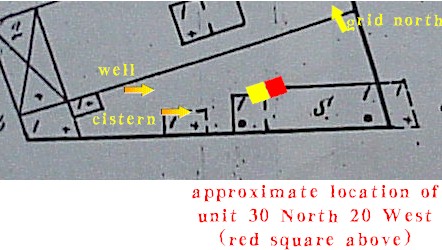 The
unit at grid coordinate 30 North 20 West (approximately located where the
red square is shown to the right) was intended to identify initial construction
levels and verify the
structural dimensions indicated on this 1887 Sanborn insurance map.
We had no reason to believe the map would be inaccurate--these insurance
maps are used by archaeologists throughout the country because of their
detail and accuracy--but we were not sure that the original lot dimensions
and placement of street and sidewalk had remained the same since the
1880s. Initially we believed that this unit probably lay completely
within the structure's foundations, so we were not really expecting to see
any foundation remains in this first unit. The
unit at grid coordinate 30 North 20 West (approximately located where the
red square is shown to the right) was intended to identify initial construction
levels and verify the
structural dimensions indicated on this 1887 Sanborn insurance map.
We had no reason to believe the map would be inaccurate--these insurance
maps are used by archaeologists throughout the country because of their
detail and accuracy--but we were not sure that the original lot dimensions
and placement of street and sidewalk had remained the same since the
1880s. Initially we believed that this unit probably lay completely
within the structure's foundations, so we were not really expecting to see
any foundation remains in this first unit. |

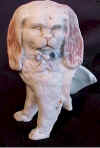 What
could this porcelain dog (left) mean? What could these 1 1/2" tall stoneware
flasks and boot (right) have symbolized?
What
could this porcelain dog (left) mean? What could these 1 1/2" tall stoneware
flasks and boot (right) have symbolized?
Victorian homes often included a vast range of
bric-a-brac like these goods from about 1850 into the early twentieth century. Most of this
material culture had no real purpose outside its decorative value, while some
goods had only marginal functional utility; e.g., the gilded vase (lower right) could
showcase flowers, but it was a piece that was itself part of household
decorative display as much as anything it held.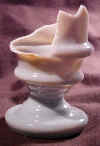
Bric-a-brac like this was produced and consumed with no clear sense of what an object or motif "communicated"; trinkets like these usually were not intended to represent anything particularly concrete, and because their symbolism was so unclear consumers could weave a wide range of meanings for them. While this symbolism was at the heart of late-nineteenth-century decorative codes, it has never really disappeared entirely: for instance, you're unlikely to find an issue of House Beautiful championing the virtues of ceramic figurines, but quite a few stores still sell everything from gnome figures to porcelain dogs, and you likely know somebody with a modest collection of such trinkets. Folks do not decorate their homes with these things because they know exactly what they mean to say about themselves through those goods; instead they like the general symbolism such symbols evoke, even if they cannot articulate that meaning. In much the same way, mass-produced Victorian baubles featured familiar symbols that were vaguely or broadly defined: bric-a-brac could evoke pleasant yet inchoate sentiments about a romanticized past, household class identity, Western cultural and racial roots, patriarchy, personal style, aristocratic behavior, or any number of things. It did not matter if a consumer could not clearly articulate the appeal of a given object; if anything, enigmatic motifs were among the most common symbols in bric-a-brac.
 The ceramic dog
is a good example of the
ambiguity that has characterized many household decorative goods since the
late-nineteenth century. Animal figurines were among the most common motifs
in Victorian bric-a-brac, and an army of animal figurines
still patrols most knick knack markets. Dog figurines like the one found at
Camp Street are commonplace in the way they present nature as completely
domesticated: in this instance, the well-behaved and well-groomed dog has
donned a bow (covered in gilding) and sits awaiting the call of her
master. This figure celebrates a civilized pet and our capability to tame
nature, and it evades the "wild" dimension of animals and humans'
inability to control nature regardless of how powerful we may be. Nobody marketed figurines of utterly wild animals out of control;
rather, they sold motifs that stressed how Culture had established its dominance
over nature. That dominance was emphasized by the small scale of the
knick knacks. This dog figure, for example, is about five inches tall, and
most bric-a-brac was on an even smaller scale. Miniaturizing
The ceramic dog
is a good example of the
ambiguity that has characterized many household decorative goods since the
late-nineteenth century. Animal figurines were among the most common motifs
in Victorian bric-a-brac, and an army of animal figurines
still patrols most knick knack markets. Dog figurines like the one found at
Camp Street are commonplace in the way they present nature as completely
domesticated: in this instance, the well-behaved and well-groomed dog has
donned a bow (covered in gilding) and sits awaiting the call of her
master. This figure celebrates a civilized pet and our capability to tame
nature, and it evades the "wild" dimension of animals and humans'
inability to control nature regardless of how powerful we may be. Nobody marketed figurines of utterly wild animals out of control;
rather, they sold motifs that stressed how Culture had established its dominance
over nature. That dominance was emphasized by the small scale of the
knick knacks. This dog figure, for example, is about five inches tall, and
most bric-a-brac was on an even smaller scale. Miniaturizing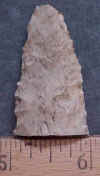 gave consumers the power to display a vast range of symbols on their
mantel: it was not uncommon for a Victorian home to showcase Presidential,
historical, Classical, natural, popular, and colonial motifs
simultaneously. These collections of miniatures were quite common in
Victorian homes and often sat alongside objects collected from nature, like sea
shells or prehistoric artifacts. Interestingly, the unit at 20 North 30
West included a prehistoric projectile point. While it may have been in
the deposit simply by chance, it could nevertheless have been part of the
household's collection, as such objects were in many other homes. A model
Victorian home typically had a few prehistoric or natural artifacts that a
family could use to stress the household member's acumen. Like the
bric-a-brac they sat alongside, these natural objects also could be used as
souvenirs with which householders relived their shared familial experiences
collecting sea shells or digging for arrowheads.
gave consumers the power to display a vast range of symbols on their
mantel: it was not uncommon for a Victorian home to showcase Presidential,
historical, Classical, natural, popular, and colonial motifs
simultaneously. These collections of miniatures were quite common in
Victorian homes and often sat alongside objects collected from nature, like sea
shells or prehistoric artifacts. Interestingly, the unit at 20 North 30
West included a prehistoric projectile point. While it may have been in
the deposit simply by chance, it could nevertheless have been part of the
household's collection, as such objects were in many other homes. A model
Victorian home typically had a few prehistoric or natural artifacts that a
family could use to stress the household member's acumen. Like the
bric-a-brac they sat alongside, these natural objects also could be used as
souvenirs with which householders relived their shared familial experiences
collecting sea shells or digging for arrowheads.
| Marbles at 800 Camp
Street
The
site includes quite a few toys, indicating that it likely was a play area
for
neighborhood children. For instance, the doll eye (right) and the
airplane fragment (left) are all that remain of two of the toys played
with in the Camp Street lot. The bisque porcelain doll body (below
left) was produced in Germany and originally had a cloth body attached to
the porcelain head. Bisque
dolls were commonly manufactured in |
In the coming months we'll post updates on our research as the lab processing and analysis moves along. We will also be conducting oral history research in the coming year and expect to post some of this material on the site as well. If you have questions about the project, comments on the analysis, or would like to participate in the lab or as an excavator next season, please email us anytime.